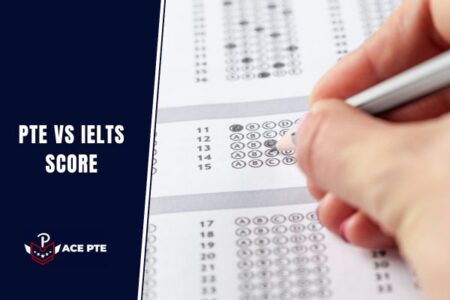PTE vs IELTS Score Comparison
In this article, we’ll break down the scoring systems of IELTS and PTE.

Scoring Systems of PTE and IELTS
Understanding the scoring systems for PTE and IELTS is crucial for choosing the right exam and interpreting your results.
PTE Scoring System
- Score Range:
- 10 to 90: Scores range from 10 (beginner) to 90 (advanced).
- Sectional Breakdown:
- Detailed Feedback: Provides individual scores for Speaking & Writing, Reading, and Listening, helping identify specific areas for improvement.
- Automated Scoring:
- Consistency and Speed: Automated system ensures objective scoring and quick results, typically available within 48 hours.
IELTS Scoring System
- Score Range:
- 0 to 9 Bands: Scores range from 0 (non-user) to 9 (expert user).
- Sectional Scores:
- Individual and Overall Scores: Each section (Listening, Reading, Writing, Speaking) is scored from 0 to 9. The overall band score is the average of these four scores.
- Scoring Criteria:
- Combination of Human and Automated Scoring: Listening and Reading sections are scored automatically. Writing and Speaking are assessed by trained examiners.
Score Comparison
It is crucial to see how PTE scores align with IELTS bands for making informed decisions. Here’s a comparison table to help you out:
PTE Score Range | IELTS Band | Proficiency Level |
86+ | 9 | Expert |
83-85 | 8.5 | Very Good |
79-82 | 8 | Very Good |
73-78 | 7.5 | Good |
65-72 | 7 | Good |
59-64 | 6.5 | Competent |
51-58 | 6 | Competent |
43-50 | 5.5 | Modest |
35-42 | 5 | Modest |
30-34 | 4.5 | Limited |
22-29 | 4 | Limited |
This table provides a clear comparison between PTE scores and IELTS bands, helping you understand the equivalence and determine your proficiency level for academic or immigration purposes.
Which Test is Easier for Achieving a Higher Score?
The computer-based format of PTE offers consistency in grading, especially in sections like speaking and writing, where human bias is removed. On the other hand, IELTS relies on human examiners for some sections, which can lead to more subjective assessments.
Additionally, PTE’s integrated questions, where a single task can assess multiple skills, often make it feel more straightforward for those comfortable with technology. The ease of scoring can vary depending on individual strengths and preferences.
Format
- PTE:
- Computer-Based: Entirely done on a computer, ideal if you prefer typing.
- IELTS:
- Paper-Based and Computer-Based Options: Offers both formats, so you can choose based on your comfort with typing or writing by hand.
Question Types
- PTE:
- Integrated Tasks: Combines multiple skills in single tasks, like summarising spoken text.
- IELTS:
- Separate Skills: Tests each skill (Listening, Reading, Writing, Speaking) separately, allowing you to focus on one area at a time.
Time Management
- PTE:
- Shorter, Varied Tasks: Keeps you engaged and helps maintain concentration.
- IELTS:
- Longer Sections: Allows more time for in-depth answers.
Personal Comfort
- PTE: If you prefer typing and quick results.
- IELTS: If you’re comfortable with handwriting and face-to-face interaction.
Choosing the “easier” test depends on what suits your personal strengths and comfort levels best.
Acceptance and Validity
- Acceptance: IELTS is widely accepted across 10,000 institutions in 140 countries. PTE is gaining ground, especially in Australia, New Zealand, and Ireland.
- Validity: Both PTE and IELTS scores are valid for two years.
Conclusion
Both PTE and IELTS are excellent options for proving your English proficiency. Consider your personal preferences, the test format you’re comfortable with, and the requirements of the universities or immigration offices you’re applying to. With the right preparation, you’ll do great on either test. ACE-PTE provides the best PTE coaching in Bangladesh. If you need help achieving a top PTE score, contact us at 01889-982918.
Resources:
